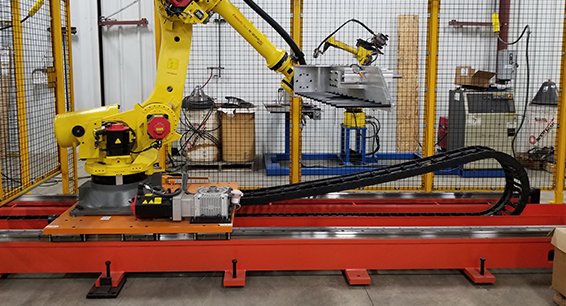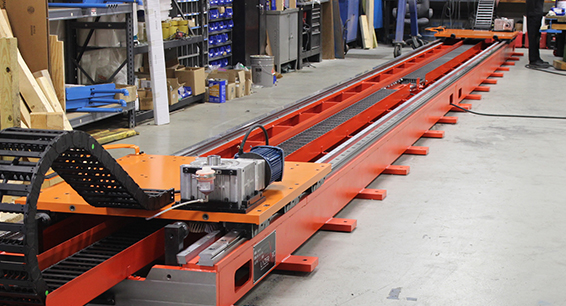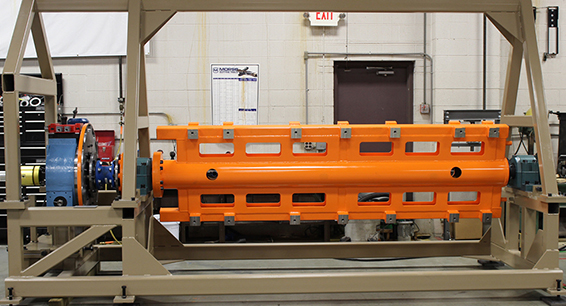Linear Transfer Units are often used with multi-axis robots in order to cost-effectively solve a wide range of automation challenges. By mounting a single robot onto a Robot Transfer Unit (a unique application of linear transfer unit technologies), factory automation engineers can improve a range of automation applications while reducing capital cost.
As the name implies, a Linear Transfer Unit can shuttle a robot quickly and precisely along a horizontal plane, adding an additional axis of movement. This makes a 6 axis robot into a 7 axis robot.
There are a wide range of jobs that need to be done to make any assembly line fully functional and optimized, let alone fully automated. Robots can lower recurring costs such as labor, can improve quality and repeatability and are a great asset to any assembly line when properly utilized and optimized. Of course, a modern robot is an expensive capital investment, so anything that can be done to get the most out of a robot investment while minimizing the number of robots needed is a good thing.
Applications where linear transfer unit and robotic automation can be particularly useful include tool feeding and changing, part feeding, welding, assembly, painting and inspection. Capabilities that make these possible include part identification, bin picking and force sensing.
Applications
Linear Transfer Units and Tool Feeding & Changing
Often as the cycle of production changes so does the required tool at that instance. Tool changeovers are often required with machining centers for instance. Robots have the ability to rapidly change tools in machining centers. Placing a single robot with a single machine tool can increase production rates, enable 24/7 'lights out' production and reduce errors and injuries. However this is an expensive investment model, and each robot in this use case requires it's own tool center that must be maintained within reach. Each robot at each machine tool therefore takes up space and resources in addition to cap-ex.
Applying a robot on a linear transfer unit lets a lone robot shuttle up and down a row of machine tools. This dramatically lowers cap-ex as well as allows the tool storage to be centralized in one location to feed multiple machines saving floor space. Additionally, if the tools are smaller in size they can all be attached to the same head of the robot and used in rotation of use.
Linear Transfer Units and Part Feeding
Feeding is the means at which you provide parts to an assembly operation. There are two primary methods for supplying parts using robotics, Flexible and Bowl feeding.
Flexible
In flexible feeding a part is laid out on a surface which the robot then identifies what it is and the orientation of it. It then picks the part up and performs the task required with that part. This type of feeding is optimal with Linear Transfer Units as a transfer table can be equipped to it and it could deliver parts to multiple fixed robots in a single trip down the assembly line.
Bowl
Bowl feeding is the means at which a part is delivered to the robot and does not require identification, as a result this is optimal for robots that operate on a single task.
Linear Transfer Units and Welding
Welding can be a natural extension of linear transfer unit mounted robots. Robots and welding have gone together for quite some time, particularly in the automotive manufacturing industry. A form of linear transfer unit with integrated robot is a 'gantry robot'. Gantry robots are linear transfer unit mounted multi-axis robots that are placed overhead. This is ideal for welding the top locations of auto bodies. Welding along very long assemblies such as bridge beams can also be accelerated with linear transfer unit mounted robotic welders.
Linear Transfer Units and Assembly
The purpose of robots on an assembly line is to assemble in the most efficient way possible. This can easily be obtained while using Linear Transfer Units as the added degree of motion allows for all related tasks to be done by the same robot at a variety of locations on the assembly line.
Linear Transfer Units and Painting
Similarly, as noted above, gantry robots are often used for painting tops of vehicles. Harley Davison famously uses linear robotics technology to paint pinstripes because the maintaining the angle of the brush along a tank is impossible to do with a standard 6-axis robot without a linear motion component.
Linear Transfer Units and Inspection
Robots can be used for inspection in the same way they identify a part. They have an image programmed that is of a properly executed part or assembly. When it is observing the final product if the product at hand does not meet the specifications of the image it would be sorted out or discarded as defective. A way to reduce waste is if the robot can identify if it is missing a certain part, that robot can take that part and add or remove what is necessary using the same vision. A linear transfer unit can be used to bring that part to the robot and fix what is defective.
Important Capabilities
In addition to adding a linear axis of motion, for the applications above there are additional important capabilities to make these applications work.
Part Identification
Part Identification is how the robot is capable of seeing what part is presented and using that identification to pick up and perform the required task. This is obviously one of the most important parts of robot assembly for if it can’t see what it is being fed, in mixed part manufacturing, no product would be produced without solid part identification capabilities.
Bin Picking
Bin picking is the process of which a variety of parts are presented to a robot and using advanced machine vision robotics, a robot is able to sort through and identify parts with increasing speed and accuracy. This is an optimal means of sorting when you have a vast variety of parts that are presented through bins. With the implementation of a Linear Transfer Unit you can have a robot on the transfer unit and is able to move and sort from bin to bin.
Force Sensing
A large part of what robots do is fastening, as a robots motor will often be able to generate torques that will shear and fracture any component that it tightens, it is vital that they can sense the force applied already and how much more is needed. This is done using a force sensor. As Forces are equal and opposite the force sensor reads the force that's been applied and alerts the robot to stop or keep tightening for a certain amount.
When you setup robots to be capable of these tasks, the efficiency of your process can skyrocket. By removing their linear range of motion constraint, in other words, lift them off their set mounts and plant them on a Linear Transfer Unit, you can produce automation solutions that are not possible or cost-effective any other way.
Other Robot Transfer Unit Synonyms:
Robot Transport Unit
Linear Transfer System
Transfer Robot
Linear Transfer Automation
7th Axis Robot
Robot Transfer Unit
Linear Motion Track
Robot Positioning Track
Robot Slide
Robot Transfer Shuttle
RTU
To learn more about these systems, see our Guide to Linear Transfer Units and RTUs here.







